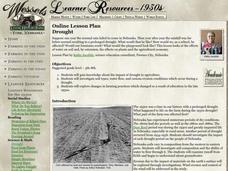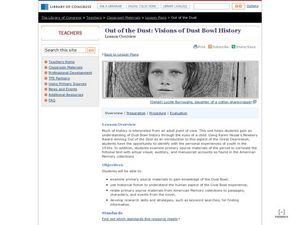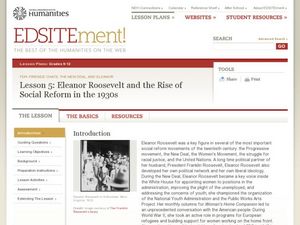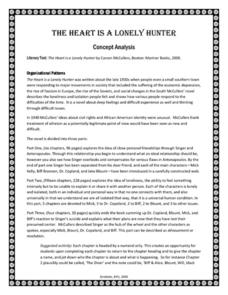Curated OER
Great Depression: Entertainment
Young scholars explore forms of entertainment during the Great Depression. In this 1930's America lesson, students consider what they do for fun today and compare to what Americans did for fun during the depression.
Curated OER
Drought
Students gain knowledge about the impact of drought in agriculture. They investigate soil types, water flow, and various erosion conditions which occur during a drought and see how farming practices changed after the 1930's.
Curated OER
Out of the Dust: Visions of Dust Bowl History Lesson Overview
Students complete activities with the book Out of the Dust by Karen Hesse. In this literature lesson, students read this story and view the Dust Bowl history from the eyes of a child. They discover the Great Depression and life in the...
Curated OER
The Dust Bowl: Out of the Dust
Is your class going to read the novel, Out of the Dust? If so, you can prep them with a presentation that provides both images of the Dust Bowl and quotes from the book. Tip: Have learners use the images to compose descriptive...
PBS
Master of the Airwaves: How FDR Used Radio to Ease the Public’s Fears
The political and economic climate during the 1930's was uncertain and tumultuous. But Americans' minds and hearts were eased with the reassuring words of their president, Franklin D. Roosevelt, and addresses over the radio. High...
National Endowment for the Humanities
Eleanor Roosevelt and the Rise of Social Reform in the 1930's
Eleventh graders explore the various roles that Eleanor Roosevelt took on. In this US History lesson, 11th graders analyze the views that Eleanor Roosevelt held as an advocate for social justice. Young scholars evaluate her contributions...
Curated OER
Slang and Dialogue in Bud Not Buddy
Students identify the 1930's slang in the novel, Bud, Not Buddy. They compare it to modern slang and rewrite a section of the book using modern slang instead of 1930's slang.
Curated OER
Mildred Taylor: Understanding the Author of "Roll of Thunder, Hear My Cry"
Middle schoolers complete various activities related to the analysis of the novel "Roll of Thunder, Hear My Cry." They create a collage of words and images of what it was like to live in the South in the 1930's, conduct Internet...
Curated OER
Norval Morrisseau
Young scholars investigate the art of Norval Morrisseau and create "x-ray paintings" using styles and symbols related to his work in this one or two day art lesson for third grade through twelfth grade. Emphasis is placed upon creative...
Curated OER
Read All About It! California History of the 30s and 40s
Explore the Great Depression! Discover the challenges people experienced during the time period. Learners investigate photographs from the Dust Bowl and WWII era and create a story line about the photographs, writing a newspaper article...
Library of Congress
To Kill A Mockingbird: A Historical Perspective
Students study the novel, To Kill a Mockingbird. Through studying primary source materials from American Memory and other online resources, students of all backgrounds study the relationships between blacks and whites.
Curated OER
Letters From Rifka
Small groups read assigned chapters from the book, Letters to Rifka, then work together to fill out comprehension worksheets associated with their chapters. This fine, 13-page instructional activity culminates with each group getting...
National Endowment for the Humanities
Scottsboro Boys and "To Kill a Mockingbird": Two Trials for the Common Core
Here's a must-have resource for anyone reading To Kill A Mockingbird or using Harper Lee's award-winning novel in a classroom. The packet contains Miss Hollace Ransdall's first-hand, factual account of the trials of the Scottsboro Boys,...
Novelinks
The Heart Is a Lonely Hunter: Concept Analysis
Considering Carson McCullers' The Heart Is a Lonely Hunter for whole-class reading or as a selection for book circles? Check out this resource that overviews the organizational patterns, themes, plot structure, tone, and setting.
Rockefeller Archive Center
Understanding Mass Media News
In an age of fake news and photoshopped images, it is vital that 21st century learners development the skills they need to evaluate mass media and assess its validity. A great way to launch such a study is with a carefully crafted lesson...
Core Knowledge Foundation
Genetics and the Master Race
How did the beginnings of genetic research influence the Nazi party? A thorough, engaging unit incorporates the work of Gregor Mendel, the study of inherited traits, and the use of racism and discrimination during the Holocaust.
Library of Congress
The Harlem Renaissance
The Harlem Renaissance brought forth many American art forms including jazz, and the writings of Zora Neale Hurston and Langston Hughes. Using a carefully curated set of documents from the Library of Congress, pupils see the cultural...
Curated OER
Pearl S. Buck: "On Discovering America"
Students describe myths and realities of immigration. In this "On Discovering America" lesson, students compare and contrast the American view of immigrants in the 1930s and how the media portrayed immigrants in the 1930s using examples...
Curated OER
Amelia Earhart: Aviation Pioneer
Students explore social practices and technological advancement of the 1920s and 1930s and relate this to modern life. They explore the events of Amelia Earhart's life and her poetry. They write their own poetry.
Curated OER
Past and Present New York Through A Comparative Study of Photography and Poetry
Students study New York in three time periods, 1890-1930, 1930's, and 1950's-60's. They discuss themes that are important in each time block. They describe a brief historical picture of each time period before they approach works of...
Curated OER
It's All In How You Look At It
Students work collaboratively to create artistic renderings of digital photographs using a color value scale and grid techniques in this late-elementary school lesson based upon Ted Rose's book Discovering Drawing. The lesson includes a...
Curated OER
History, Literature, Art: Connections
Eleventh graders read either The Death of the Ball Turret Gunner, The Crucible, or Hiroshima, and examine connection between art and literature by relating particular works of art to their readings, relying on both visual and written...
Curated OER
Out of the Dust
Students examine 1930's America through literature. In this Dust Bowl lesson, students read Karen Hesse's Out of the Dust and set up vocabulary journals and question bookmarks to log their thoughts and impressions as they read the novel.
Curated OER
Read All About It! Events and People of the 1930s and 1940s That Shaped California and the Nation.
Learners look carefully at four photographs by Dorothea Lange and discuss them in terms of what is depicted and what she may have wanted to communicate. They review what they learned about the Dust Bowl, the Depression, the war era, and...

























